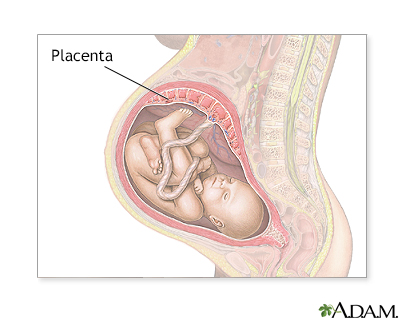Pregnancy SmartSiteTM
Vaginal bleeding - placenta previa; Pregnancy - placenta previa DefinitionPlacenta previa is a problem of pregnancy in which the placenta grows in the lowest part of the womb (uterus) and covers all or part of the opening to the cervix. The placenta grows during pregnancy and feeds the developing baby. The cervix is the opening to the birth canal. CausesDuring pregnancy, the placenta moves as the womb stretches and grows. It is very common for the placenta to be low in the womb in early pregnancy. But as the pregnancy continues, the placenta moves to the top of the womb. By the third trimester, the placenta should be near the top of the womb, so the cervix is open for delivery. Sometimes, the placenta partly or completely covers the cervix. This is called a placenta previa. There are different forms of placenta previa:
Placenta previa occurs in 1 out of 200 pregnancies. It is more common in women who have:
Women who smoke, use cocaine, or have their children at an older age may also have an increased risk. SymptomsThe main symptom of placenta previa is sudden bleeding from the vagina. Some women also have cramps. The bleeding often starts near the end of the second trimester or beginning of the third trimester. Bleeding may be severe and life threatening. It may stop on its own but can start again days or weeks later. Labor sometimes starts within several days of the heavy bleeding. Sometimes, bleeding may not occur until after labor starts. Exams and TestsYour health care provider can diagnose this condition with a pregnancy ultrasound. TreatmentYour provider will carefully consider the risk of bleeding against early delivery of your baby. After 36 weeks, delivery of the baby may be the best treatment. Nearly all women with placenta previa will need a C-section. If the placenta covers all or part of the cervix, a vaginal delivery can cause severe bleeding. This can be deadly to both the mother and baby. If the placenta is near or covering part of the cervix, your provider may recommend:
Nothing should be placed in your vagina. You may need to stay in the hospital so your health care team can closely monitor you and your baby. Other treatments you may receive:
An emergency C-section may be done if the bleeding is heavy and cannot be controlled. Outlook (Prognosis)The biggest risk is severe bleeding that can be life threatening to the mother and baby. If you have severe bleeding, your baby may need to be delivered early, before major organs, such as the lungs, have developed. For most women who receive regular prenatal care, this condition is diagnosed before symptoms appear. This helps the provider and mother take steps to minimize risks from this condition. When to Contact a Medical ProfessionalContact your provider if you have vaginal bleeding during pregnancy. Placenta previa can be dangerous to both you and your baby. ReferencesFrancois KE, Foley MR. Antepartum and postpartum hemorrhage. In: Landon MB, Galan HL, Jauniaux ERM, et al, eds. Gabbe's Obstetrics: Normal and Problem Pregnancies. 7th ed. Philadelphia, PA: Elsevier; 2021:chap 18. Hull AD, Resnik R, Silver RM. Placenta previa and accreta, vasa previa, subchorionic hemorrhage, and abruptio placentae. In: Lockwood CJ, Copel JA, Dugoff L, et al, eds. Creasy and Resnik's Maternal-Fetal Medicine: Principles and Practice. 9th ed. Philadelphia, PA: Elsevier; 2023:chap 43. Henn MC, Lall MD. Complications of pregnancy. In: Walls RM, ed. Rosen's Emergency Medicine: Concepts and Clinical Practice. 10th ed. Philadelphia, PA: Elsevier; 2023:chap 173. | ||
| ||
Review Date: 4/16/2024 Reviewed By: John D. Jacobson, MD, Professor Emeritus, Department of Obstetrics and Gynecology, Loma Linda University School of Medicine, Loma Linda, CA. Also reviewed by David C. Dugdale, MD, Medical Director, Brenda Conaway, Editorial Director, and the A.D.A.M. Editorial team. View References The information provided herein should not be used during any medical emergency or for the diagnosis or treatment of any medical condition. A licensed medical professional should be consulted for diagnosis and treatment of any and all medical conditions. Links to other sites are provided for information only -- they do not constitute endorsements of those other sites. No warranty of any kind, either expressed or implied, is made as to the accuracy, reliability, timeliness, or correctness of any translations made by a third-party service of the information provided herein into any other language. © 1997- A.D.A.M., a business unit of Ebix, Inc. Any duplication or distribution of the information contained herein is strictly prohibited. | ||


 Cesarean section
Cesarean section Ultrasound in preg...
Ultrasound in preg... Anatomy of a norma...
Anatomy of a norma... Placenta previa
Placenta previa Placenta
Placenta Ultrasound, normal...
Ultrasound, normal... Ultrasound, normal...
Ultrasound, normal... Ultrasound, color ...
Ultrasound, color ... Placenta
Placenta
